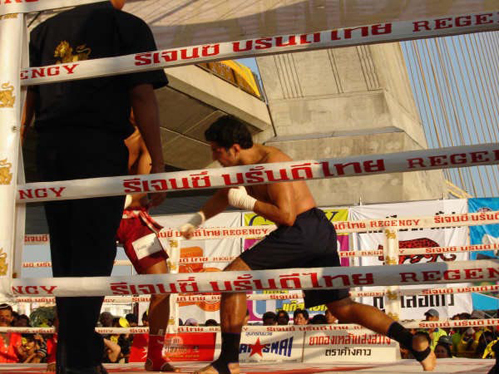
At 38 years old, Vancouver BC based Medhi Pouroskoui has been among the few foreign muaythai fighter’s who has won professional muaythai championships in Thailand and has fought in both Lumpini and Rajadamnern stadium’s.
He has beaten the Thai’s at their own game, knocking out many of his opponents with his punching ability, and unbelievably -- taking these fights at a moment’s notice and usually winning within the first or second rounds!
Besides being an active muaythai fighter and boxer, Mehdi coaches a stable of up and coming fighter’s, he also trains MMA contenders in the finer points of striking.
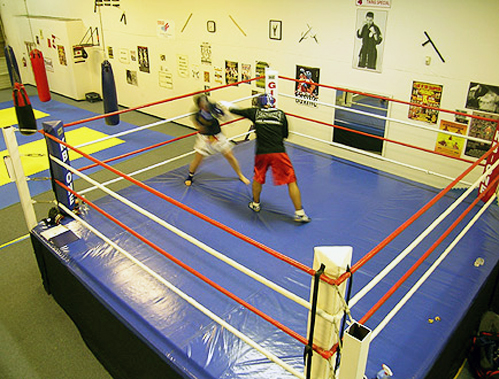
RF: I’m sure you’re familiar with the old cliché, “A punch is a punch, and a kick is a kick!” But there is a huge difference between the punches and kicks of theatrical (traditional) styles and that of boxing and muaythai.
Mehdi: Well, in theory it sounds good, however – a boxer’s punch and a muaythai kick are quite different from other types of punches and kicks, in fact, there’s no comparison.
RF: I’ve always believed that the most effective striking skills by a large margin derive from two sources, boxing and muaythai.
Mehdi: Absolutely, I don’t think it’s a secret most traditional martial artists usually avoid the full-contact game because they know they’ll be hurt. They’re priorities are not the same.
RF: Why are these two striking styles far above the others?
Mehdi: It’s the way [boxing and muaythai] implement their strikes, besides using the entire body, we employ fakes. More importantly, boxing and muaythai practitioners learn distance, timing, transmission of power, and also learning how to deal with being hit.
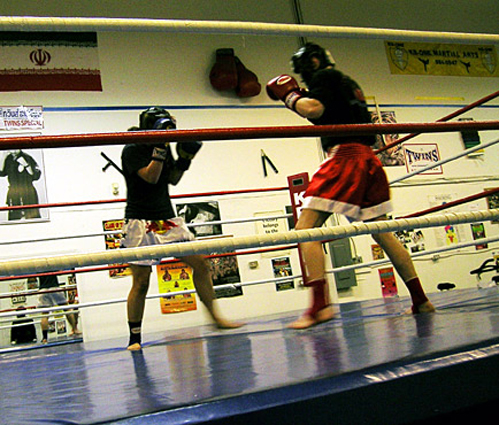
RF: I always tell my students that it’s important to have at least a cursory understanding of these sports for two important reasons: #1. Incorporating some of these skills into your self-defense toolbox and #2. Knowing what you are potentially up against if you’re up against an experienced fighter.
Mehdi: Exactly, even if you don’t have much time to pursue boxing or muaythai, it’s important to at least take an introductory class in either sport to become familiar with the basic concepts. What you don’t know can hurt you!
RF: Finding a legitimate boxing instructor is straightforward, statistics of who’s who in the boxing world are easy to find. However, in the world of muaythai, things are quite different. Many association’s exist in muaythai (more than a few of them dubious).
Mehdi: Oh that’s the biggest problem in muaythai, each association claims to have their own world champions, and the language issue doesn’t help either, it’s an additional barrier to getting the information straight. In Thailand, everyone knows who the real champions are.
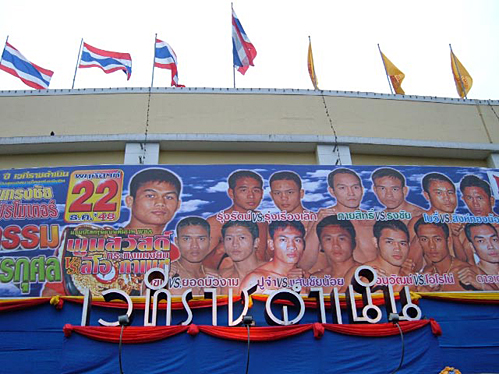
RF: What are the official organizations?
Mehdi: There are two legal/official associations in Thailand. The WMC (World Muaythai Council) and the newer WPMF (World Professional MuayThai Federation).
RF: Many muaythai students in Europe and the Americas claim to have fought in Thailand against top champions, and when you see their photos, they look like they were taken in some obscure backwoods location.
Mehdi: In truth, many foreigners often fight in sham tourist fights, these are Mickey Mouse fights usually setup by greedy promoters against older fighters; this is done so they can claim a win over a Thai. There’s nothing wrong with fighting these guys but don’t claim your opponent was the world muaythai champ.
RF: So how can you distinguish between a real and sham fight?
Mehdi: Top caliber fights are usually held at the two biggest stadiums, Lumpinee and Rajadamnern. These fights are by invitation only, and few foreigners are invited.
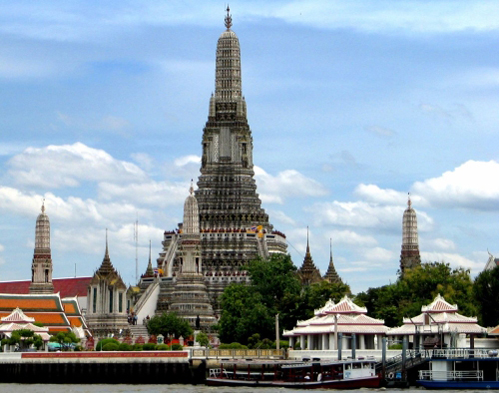
RF: When was your first professional fight in Thailand and with whom?
Mehdi: My first official fight in Thailand was in 2002, I lost my fight in a decision, but my opponent was Ponmonkon, the reigning champ in my weight-class for the previous 10 years.
RF: Have you had any recent fights?
Mehdi: My latest fight was a boxing match at the Emerald Queen Casino, Proboxing in Tacoma, WA on Jan. 19th, 2008. I lost a decision to Robert Breu, cruiser weight -- I took that fight on a 2-week notice.
RF:Any muaythai fights coming up?
Mehdi: My next fight will be the Muaythai World Championship WPMF (World Professional MuayThai Federation). for the King’s (of Thailand) birthday on Dec. 2008, in Bangkok, Thailand. As usual, this an invitation only event
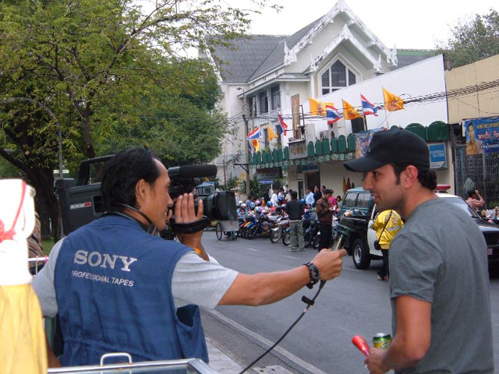
The Muay Boran Fight
RF: Tell us about your Muay Boran fight in Rajadamnern
Mehdi: I was scheduled to fight in Rajadamnern stadium on December 18, 2005. I started training in November (in Vancouver). I left for Bangkok on December 8th to be there 9 days before the fight.
As usual, long distance trips usually go awry and this time my luggage was delayed so I had to wait at the airport after I arrived. I met my Thai manager (and instructor) at the airport and he explained he had a Russian fighter up for a bare knuckles event (only a few hours later in the day), but the guy suddenly disappeared. (In Thailand, it’s a huge loss of face is a manager doesn’t show up with his fighter.)
I asked him about the event and he mentioned it was a “Muay Baron” (bare knuckle) event, just legalized in Thailand. It was also being televised internationally. Coincidentally, the weight class was the same as mine, 80kg (175lbs), I asked him if he wanted me to fight? I wanted to help him out and at the same time was intrigued by the nature of the fight so I volunteered.
RF: And the fight was just a few hours later in the day?
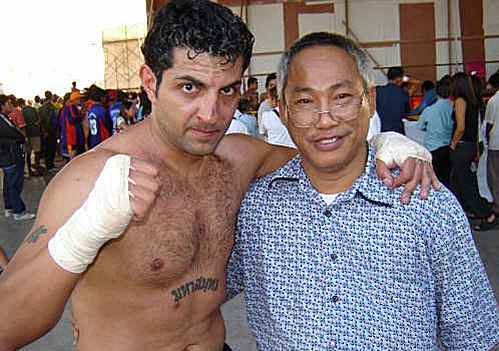
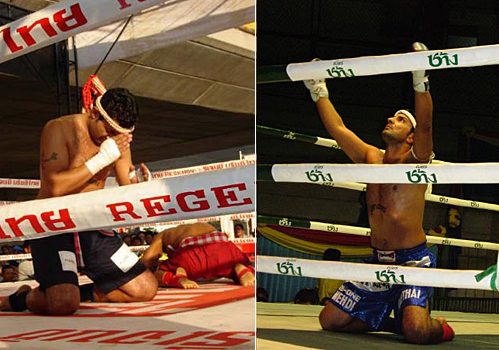
Mehdi: Yes, we went to the hotel to drop off my stuff, I took a shower and got my mouthpiece and left. When I arrived I rushed to the weigh-in and filled out the forms.
RF: Weren’t you heavily jet-lagged from your trip?
Mehdi: I felt it coming on strong just as they were wrapping my hands.
RF: In Muay Boran, do they wrap you differently than in muaythai?
Mehdi: Yeah, they wrap you in gauze and tape, but only minimally
RF:And your fight was less than an hour away at that point?
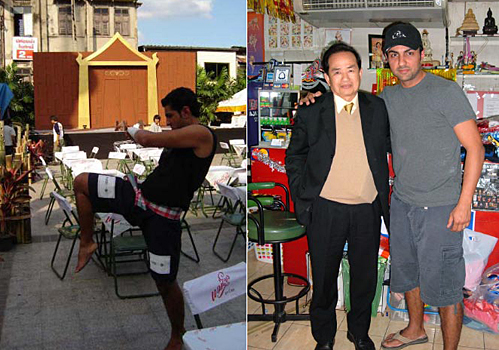
Mehdi: Yes, I was the third fight, I had to stretch, warm-up and get ready. For me it was 2:00 AM in the morning, but I shook it off and focused on the upcoming event.
The first two fights went quickly. Then they called my name and I entered the ring. My opponent was from Burma and quite experienced in this style of fighting.
First-Round
During the first minute we were just reading each other but shortly thereafter started exchanging punches, elbows and kicks (the fight was 5 X 3 minute rounds). This guy really hit hard and I thought, what the hell am I doing here, but I pushed those thoughts from my mind and decided to fight hard until the end. Towards the end of the first round I really began to feel the jet-lag, my knees were wobbling, but I just pushed forward.
Second-Round
In the second round he hit me with a right rib kick and I countered with a straight right punch. I knew I hurt him when he started backing into the ropes so I threw a flurry of punches. This guy was really tough, but after 3-4 clean punches to his temple I knocked him out. It was over and I won, I was glad and felt relieved, this guy was so tough. I was bruised all over, I had a broken rear tooth (from an elbow) a cut over my left eye, and for months thereafter, pain in my hands.
*This fight can be seen at the end of this article.
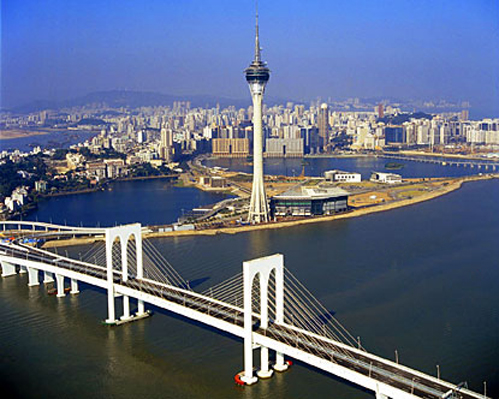
Fight in Macau
RF: Tell us about the fight in Macau
Mehdi: On May 10th/2007 I received a call from my manager in Thailand asking if I could fight the Macau muaythai championship in the 80kg (175lbs) weight-class (a big event presented by Billy’s kickboxing in HK). At the time I was 187lbs. I asked him the date of the fight and he said it was only 2-weeks away. I had to lose 12 pounds fast and be in fight shape, I wasn’t sure if I could pull it off?
RF: How did you train for this fight?
Mehdi : My training consisted of heavy cardio during the day, which was running a steep mountain trail (a 1-1/2 hour run), lots of bag and pad work in the afternoon and 10 rounds of semi hard-contact sparring (so I wouldn’t get injured). I had a strict diet, absolutely no carbs (to drop the weight).
I flew to Macau on May 28th and arrived on the following afternoon. I made the weight for the fight and also saw my opponent Porthong for the first time, a typically strong and skillful fighter from Thailand with lots of fights under his belt.

RF: You were ready to fight after a 20-hour flight?
Mehdi: The jet-lag always hits me a few hours later. It’s tough to fly 20 hours and fight the next night. I fell sleep around 8:00 PM and woke up at 4:00 AM, had breakfast at 6:00 AM and stayed in the room all day but couldn’t sleep.
I left the hotel at 5pm and walked towards the venue which was close to the hotel. My manager’s advised me not to get into a kicking war with my opponent and just try to get close and use my hands.
The fight consisted of 5 X 3 minute rounds. By the time my fight came up it was already 11:30 pm, I started to feel the jet lag taking over, but I kept telling myself I did not come all the way here to lose.
Round 1
The fight started with my opponent throwing several fast kicks towards my ribs and I knew I have to get close to punch him. During one of his kicks I grabbed his leg and swept his other leg aggressively and he took a hard fall. I winded him a bit and then I started closing in, using my jab and throwing a lot of hooks and uppercut combinations but he was very tough. Eventually, after getting 2 standing 8 counts the referee stopped the fight and I was announced the winner by TKO into 2-minutes and 45-seconds of the first round.
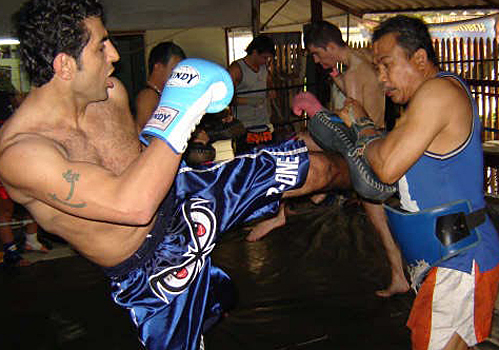
On MMA and Training
RF: With such superlative striking skills why haven’t you ventured into MMA?
Mehdi: MMA requires lots of time in training; besides working on striking skills you need to spend hours each day drilling grappling skills as well. I’m very passionate about striking sports and choose to dedicate my efforts to this end. In addition, in between fights I coach about half a dozen contenders in muaythai, there’s just no time left.
RF: What’s your take on K-1?
Mehdi: K-1 has some of the best stand up fighters in the world and K-1 Max is even better because it offers the lower weight classes and far more action than the UFC.
RF: How different is the striking?
Mehdi: They integrate the hands and legs in a similar way that I do, very close to the Dutch style.
RF: In Thailand you don’t see a lot of hand and leg integration, what are other differences between muaythai and K-1?
Mehdi: In Thailand people want to see a lot of legs, they want to see dazzling and unorthodox techniques such as flying knee kicks. In Thailand you can stay in the clinch all day, but K-1 doesn’t allow that. K-1 also uses more hands than they do in Thailand.
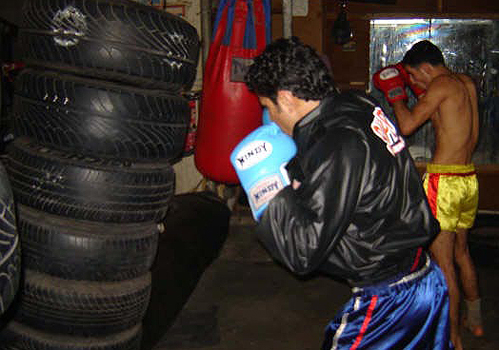
RF: Very few strikers dominate MMA events nowadays, why is that?
Mehdi: The UFC and similar events are dominated mainly by grapplers, many strikers today either don’t work enough on their striking game, or they underestimate it completely. Unfortunately, many MMA fighter’s don’t work with qualified boxing/muaythai coaches.
RF: It ‘s getting a little better, Cung Lee recently broke Frank Shamrock’s arm with a kick and won the Elite XC championship in his weight class.
Mehdi: That’s a great example, there are a few really good strikers out there, Wanderlei Silver, Chuck Liddel etc. and I see more striking happening in the UFC and Elite XC.
RF: You’re concentrating more on coaching nowadays
Mehdi: Yes, I’ve been training my own stable of fighter’s for the past 12 years now and also train a lot of MMA guys who need to add some effective striking skills.
I’m also developing a team to attend the muaythai amateur world championships in Thailand. This consists of a team of 10 students (males and females) and gives them experience in a properly sanctioned muaythai fight.
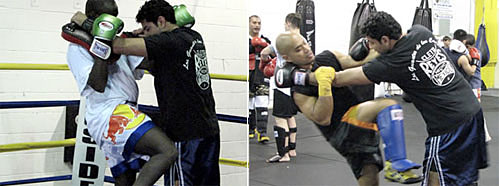
RF: How do you train students that have specific fights coming up?
Mehdi: Everyone who comes to me has different strengths and weaknesses and I specifically help them train to improve their weak side. In addition, I am mindful of who they are going to fight and train them to overcome that particular person’s style. I train all my students in heavy cardio, that is, lots of bag and pad work, as well as cross-fighting.
RF: Your muaythai hand style is more like boxing than muaythai
Mehdi : Yes, it’s more boxing based, but not completely I’m always mindful of how low I can duck, since I’ve seen many fighters get a knee in the head, that can stop a fight fast.
RF: How did the Dutch become the best standup fighters in Europe and among the best in the world?
Mehdi: The Dutch are able to combine their hands and feet together and use them well. They do lots of boxing, light sparring, and cross-fighting. (light sparring), with hard training and lots of repetitions, this enables them to react faster and the movements become second nature.
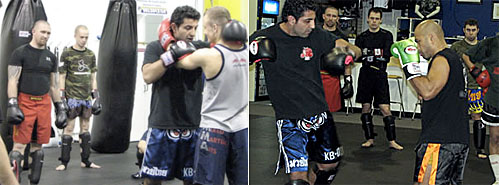
RF: Karate and kung fu fighters come into muaythai and MMA clubs and consistently and easily get beaten, why is this, what do they do wrong?
Mehdi: Karate and Kung Fu are very traditional styles, whereas, MuayThai has evolved to a more modern and realistic way of fighting. In addition, Kung Fu and Karate practice lots of patterns/forms which makes less able to react to a real attack. I mean, there are some good karate people, but pound for pound, a muaythai fighter is a much better fighter than any traditional stylist [I know, I practiced karate for years].
RF: What’s the main component of boxing and muaythai’s effectiveness?
Mehdi: Learning how to penetrate and transfer power, doing few techniques with lots of repetitions, 3-6 hours a day -- doing same things over and over.
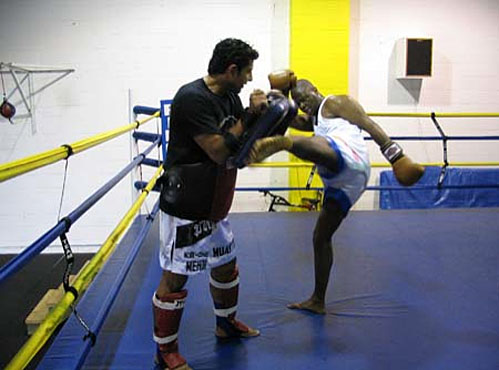
RF: What techniques do you recommend for the street?
Mehdi: For the street, a fast and powerful leg kick can quickly end an engagement. Clinch work, elbow and knees are also important.
RF: The clinch seems to be the least understood component of the fight game outside of muaythai and wrestling.
Mehdi : I incorporate clinches in all my training during muaythai cross-fighting rounds. Clinching is also important for the street well as MMA – it puts you in a position to control the opponent, then strike or throw him.
RF: You mentioned the best cardio work is done not by only running
Mehdi: Yes, not only by running but with bag work, light sparring, pads, skipping rope, lots of long rounds on the bag with fast combos.

RF: There seems to be a huge tourist trade to learn muaythai in Thailand. I don’t know if that’s the best approach, what do you suggest?
Mehdi: Going to Thailand is great but first learn your muaythai basics somewhere else. Spend at least 6-months practicing with a certified instructor. If you just show up at a camp in Thailand, you’ll just end up hitting pads, and working with a trainer you won’t understand. You won’t learn skills, you may even get hurt.
The best way is to find a training center that can certify you with their home organization in Thailand. That way you will be a welcome guest. For example, I represent an organization in Thailand that allows me to certify students in North America. Therefore, when I send students to train in Thailand, they get good training and can improve their skills.
More About Muay Boran
Muay Boran which means to "Ancient Boxing", is the predecessor to muaythai. Muay Baron was originally practiced in Southeast Asia, specifically more in Thailand, Burma, Laos and Cambodia. It’s a rare form of muaythai but even in Thailand it’s becoming increasingly difficult to find a school willing to teach it.
With the absence of gloves and protective gear Muay Boran's goal is to maximize the amount of damage that each blow can inflict, this often leads to serious injury. Various moves in Muay Boran are forbidden in present-day Muay Thai competitions.
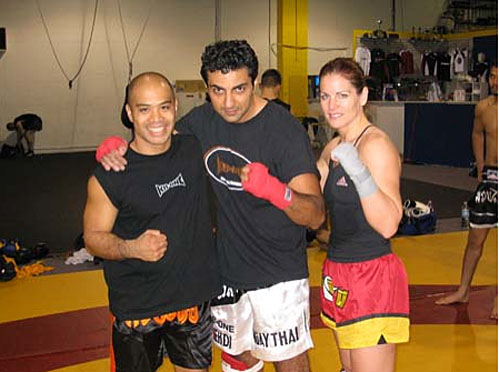
Instructor’s Course
Mehdi offers a three level instructor’s course at his school in Vancouver BC for those individuals wishing to become an assistant instructor as well as full instructor. This also includes fundamentals of building and running a business. This course is officially certified through Thailand.
*Mehdi is a muaythai fighter, boxer and coaches both disciplines. He is available for seminars in: muaythai, K-1, MMA (striking) and boxing.
*Mehdi can be reached through his site: www.KB-One.com
His email is: twinscanada@hotmail.com